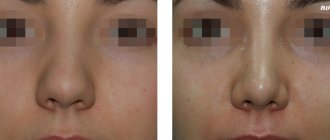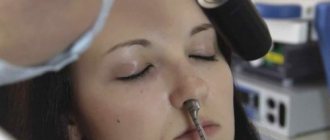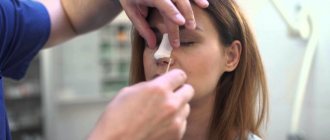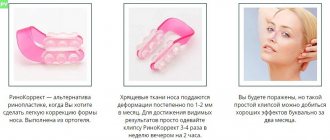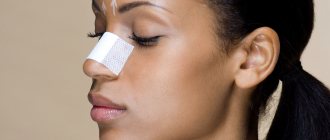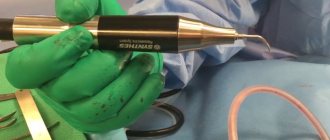According to statistics, 5 out of 10 people would like to change the shape of their nose, but are not ready to go under the knife of a plastic surgeon. A way out of the situation may be non-surgical rhinoplasty, a safe procedure that allows you to correct existing aesthetic defects of the nose in a couple of hours without undergoing global intervention. This decision is especially relevant for those who have not yet fully decided and have not decided on the need for radical changes in appearance.
Contour rhinoplasty will help:
- remove asymmetry;
- straighten the nose;
- reduce the tip of the nose
Injection rhinoplasty is performed using:
- fillers, for example, with hyaluronic acid;
- hormones, for example, Diprospan.
Safe and quick methods of non-surgical rhinoplasty include nose correction with threads or the application of a splint.
Separately, we will consider a modern method of nose correction without surgery - rhinoplasty with lipolytics.
What are lipolytics
Lipolitics are drugs whose action is aimed at burning subcutaneous fat, turning it into acids. The product is used to remove layers of fat, which helps reduce tissue volume. Lipolitics are used for the face, in particular the nose, mainly due to their safe action, because they are made from natural ingredients. According to customer reviews, the body responds well to the action of the drug. These drugs belong to mesoinjections; they are injected into the desired place using special thin needles, which reduce trauma to zero. Today, there are two main types of lipolytics, the difference between which is the method of action on the tissue.
Hormonal correction
Another method of nose correction is injections of artificial hormonal drugs (popular Diprospan, Kenalog). They act on the principle of dissolving cartilage tissue. Indications for use: hump, correction of the wings and tip of the nose. They often receive negative reviews due to poorly predicted results. The thing is that a simple input technique is preceded by complex calculations of the required amount of product.
How do lipolytics work?
The product is a biologically active material that is aimed at burning subcutaneous fat. During the chemical breakdown of fat, acids are formed, which are removed from the body naturally. Lipolitics have an additional lifting effect, making the skin soft and smooth. It is recommended to use this product in the presence of uncontrolled fat deposits on the body.
Note! Lipolitics are not a magic drug that will turn a fat person into a thin one. This remedy can provoke only minor weight loss. To get the full result, you need to add nutrition and exercise, or resort to liposuction.
Main types of lipolytics.
- Direct . These drugs have the most powerful effect, due to which they destroy not only the fat cell itself, but also its membrane.
- Indirect . A more gentle product based on herbal ingredients. Some of the most popular are caffeine or artichoke extract. This type of lipolytic is not capable of leading to dramatic changes, but will significantly improve the condition of the skin.
To fully consolidate the result after injections, additional drugs are used that promote the excretion of fatty acids. However, it is recommended to use these remedies only if it is impossible to lose weight in other, more gentle ways.
Contraindications
Like any procedure, non-surgical rhinoplasty has a number of contraindications. You must notify your doctor of any diseases, allergic reactions, or malaise. So, contraindications to non-surgical rhinoplasty:
- period of pregnancy and lactation;
- increased tissue bleeding;
- the presence of acute inflammatory processes in the body;
- elevated temperature, fever;
- infectious diseases;
- herpes (active form);
- decompensated form of diabetes mellitus;
- allergy to the drug used or its components.
Reducing the nose with lipolytics
Lipolitics can cope with wrinkles and folds on the nose. The most widely used drug for nose correction is Dermaheal. It contains: hyaluronic acid, carotene, phosphatidylcholine and other beneficial substances. This powerful drug will help correct the so-called “fleshy nose” and help remove acquired and congenital folds. Unfortunately, it is very difficult to achieve a radical change in the nose with the help of these drugs. Reduction of the tip of the nose with lipolytics will only be achieved slightly. In order to understand this, you need to remember the anatomy of the nose. There is little subcutaneous fat in this organ, so only in obese people the effect will be clearly noticeable. Doctors recommend considering other rhinoplasty methods.
Non-surgical rhinoplasty: experts talk about the pros and cons of the procedure
Previously, those who wanted to change the shape of their nose went straight to the surgeon's office.
There were no other options. However, for some time now, cosmetologists have learned to use injectable preparations (for example, gels based on hyaluronic acid) to correct the profile in less than 15 minutes. We learned from the experts all the intricacies of non-surgical rhinoplasty. The American cosmetologist Alexander Rivkin is considered the inventor of the non-surgical rhinoplasty technique (he performed this procedure back in 2002), although hundreds of plastic surgeons and dermatologists now offer this service around the world. The before and after photos are so incredible that many people think they can change the shape of their nose during their lunch break. However, everything is not so simple.
How it works?
Most fillers provide a temporary effect (from three months to two years, depending on the type of drug chosen).
Many people do not understand why injections are necessary if the results are fleeting. For example, Volumema lasts for a year and a half. Once the drug dissolves, many move on to Bellafill (a collagen-based injection commonly used to treat acne scars). The effect after its introduction lasts for years, notes Alexander Rivkin.
Correction methods
Botulinum toxin injections
In people with developed nasal muscles, the tip of the nose usually drops down (the so-called “droopy” nose). Botulinum toxin relaxes facial muscles and blocks the appearance of wrinkles. Modern formulations of the drug are practically safe, but there are individual contraindications.
If there is drooping of the tip of the nose when smiling or talking, it would be better to inject botulinum toxin into the muscle that lifts the upper lip and the wing of the nose,
— comments the head of the anti-age department of the LazerJazz clinic, Aptos trainer, dermatologist-cosmetologist Marina Miusova.
Pros: there is no rehabilitation after the procedure, practically no contraindications. As a result, the correction is very delicate.
Cons: it is impossible to radically correct the shape of the nose.
Filler injections
If the bridge of the nose and the bridge of the nose are low, filler injections are a more effective and simple way to correct the shape.
Although injections are less traumatic (not like surgical correction!), after the injection of filler, its volume decreases due to biodegradation, so to maintain the effect, it is necessary to repeat the procedure periodically, says the expert.
Pros: low-traumatic, fast, effective when the bridge of the nose and bridge of the nose are low.
Disadvantages: with their help you cannot make the tip sharper, raise it, get rid of the hump and narrow the wide nose. You also need to repeat the procedure about once a year to maintain the effect.
There is complex blood circulation in the nose area, so a doctor’s mistake during the injection is fraught with edema, ischemic lesions on the skin and thrombosis of the vessels supplying the frontal part of the face and the nose itself.
Thread correction
Recently, methods of nose correction using threads have become very popular. With their help, you can significantly correct the shape of your nose: raise the tip and make it sharper, even out asymmetry, smooth out a hump, you can even visually shorten your nose. But this method also has its limits of what is possible - it is impossible to narrow the wings of the nose and remove the hump completely.
Pros: the procedure is fast, effective and safe, the results last a long time.
Cons: there is rehabilitation, bruising and swelling may occur.
Lipolitics
These drugs eliminate subcutaneous fat and intercellular fluid - it is their excess that gives the nose a massive appearance.
Pros: Helps make your nose look smaller.
Cons: the effect of lipolytics can spread to the cartilage structure and degenerate the “framework” of the nose. Such consequences will have to be corrected surgically.
Hormonal drugs
They destroy subcutaneous fat, affecting the cartilage and septum, which makes it possible to narrow the volume of the back, reduce the volume of the cartilaginous part and tip.
Plus: permanent results.
Cons: unfortunately, it is extremely difficult to predict the exact result. Uncontrolled metamorphosis can result in softening of the cartilage and blockage of blood vessels, followed by ischemia, which manifests itself as whitish spots at the injection sites.
Rehabilitation
If there was a pain scale, Botox would be at the bottom (you can barely feel the injections), cheek injections would be towards the top. Lip injections are somewhere in the middle. What about non-surgical rhinoplasty? All experts say it is almost painless. But some patients still choose to use a local anesthetic to numb the area. However, even ordinary ice helps.
Risks
The advantages of non-surgical plastic surgery are obvious: a “new” nose without anesthesia and a scalpel, fast rehabilitation and relatively low cost. But even seemingly safe methods have disadvantages. All injections are risky. Swelling, bruising, and bleeding may occur. The nose is a particularly delicate area of the face.
Procedures in the nasal area are considered the most dangerous because the blood supply to the nose is quite poor. This is not a procedure that can be done “on sale.” Before deciding on non-surgical rhinoplasty, you need to make sure that the doctor is competent and ask to be warned about all potential risks, the expert notes.
Plastic surgeons most often oppose this type of correction. They are sure that real rhinoplasty cannot be performed without surgery - surgical changes in the structures of the nose, work with bone and cartilage tissues, and mucous membranes. But cosmetologists, in their opinion, cannot do such things: surgical skills and knowledge of an ENT doctor are required.
Personally, I do not carry out such a procedure separately, but in exceptional situations I can use it after surgery as an auxiliary tool. For example, we performed rhinoplasty, but the back sagged and became slightly concave. In this case, you can inject a small part of the drug and thus raise it. When the drug dissolves, its own connective tissue will already form in that place and the back will stand up as it should. That is, in this case, the filler plays the role of a temporary fixative, but nothing more,” Otari Gogiberidze, leading plastic surgeon at the Time of Beauty clinic, explains his position.
According to the expert, it is not worth correcting the shape of the nose with injectable drugs on a regular basis.
Constant tissue trauma can lead to scarring. But, alas, this often happens: the patient changes the shape of the nose with the help of fillers, and after a few months everything resolves and correction is inevitably required, says Otari Gogiberidze.
The most dangerous thing, according to the surgeon, is when it is not drugs based on hyaluronic acid that are injected, but non-absorbable biopolymers. This can cause tissue thinning, necrosis and deformation of the nose. And in the end, you will still have to go to a plastic surgeon to correct the situation. But working with this will, of course, be more difficult than with an “untouched” nose.
Plastic surgeon Dmitry Skvortsov, winner of the Crystal Lotus 2019 award in the category “Best plastic surgeon for rhinoplasty,” also agrees with the previous expert.
Injection techniques are appropriate for correcting small defects, but only a plastic surgeon can predict and provide a lasting natural result. There is the so-called “conserving rhinoplasty” and, in particular, low-traumatic ultrasound correction of the nose using a piezotome. The volume, course and appropriate method of correction should be determined in detail in consultation with a qualified and experienced specialist,” he says.
Price
The average cost of rhinoplasty in Russia is 250 thousand rubles. Non-surgical rhinoplasty using Voluma gel will cost 60 thousand rubles per year. It cannot be said that the procedure saves money, but it is performed without general anesthesia and does not have irreversible changes.
Cosmetologists about lipolytics
Modern cosmetologists unanimously agree that lipolytics will help take the fight against excess weight to a new level. The advantage of these drugs over similar ones is the possibility of significantly improving the quality of the skin, due to the presence of hyaluronic acid in the composition. Other components, such as plant extracts and vitamin complexes, will help improve skin color and restore its youth. Before the advent of lipolytics, excess weight was fought only with the help of liposuction, which is a rather painful procedure. Now it will be replaced by a low-pain correction, with no risk of injury.
However, it is worth noting that in practice the stunning weight loss results that the manufacturers claim were not observed.
Operation technique
Thread correction
Non-surgical rhinoplasty with threads is effective if the patient would like to slightly shorten the length of the nose and smooth out the hump.
Threads are often used for non-surgical rhinoplasty of the tip of the nose: it can be raised with the help of such a correction. This is a fairly common request in our clinic.
The result of non-surgical rhinoplasty with threads will be visible immediately, but will last no more than 1-2 years.
If desired, the patient can repeat the procedure before the effect wears off.
The non-surgical rhinoplasty procedure is performed by a cosmetologist in a modern medical office. Local anesthesia is used. Threads (APTOS, Dermafil Happy Lift, etc.) are inserted through micropunctures into a specific area of the nose (wings or tip). Next, the doctor performs a “lift” of the required area: thus, it is possible to give the nose the desired shape. You will be able to see the effect immediately after the procedure, but it is better to evaluate the final result after 2-3 days, when the slight swelling has subsided.
Reducing the nose with lipolytics reviews
Albina, 30 years old I read a lot about lipolytics, about their miraculous effect. I suffer from excess weight, which is especially noticeable in my face, which always seems to be swollen. Big cheeks and a fleshy nose. It seemed to me that it was impossible to reduce my nose without surgery. It was a little scary to go under the needles, but beauty is more important. I went for a consultation with a doctor, where he explained to me what effect I could ideally expect. The procedure went quickly, there was practically no pain, only the face was scary. They selected the drug RevitalCelluform for me. There was no rehabilitation. Of course, I expected more, but after a week, my face actually became smaller, my nose seemed to have deflated. I don’t know how long the effect will last, I’ll watch. The skin became like a baby’s, smooth and has a healthy, fresh appearance.
Definition and indications
Non-surgical rhinoplasty is a cosmetic term that implies a set of various procedures aimed at non-surgical correction of the nose. As a rule, they form a temporary effect and have a strict list of indications, which include:
- the presence of scars and other visual mechanical injuries on the skin;
- lack of symmetry;
- raised or lowered tip of the nose;
- insufficient volume of the tip of the nose;
- the presence of dips or sharp, protruding corners;
- sagging skin;
- ptosis;
- hump.
In this case, it will not be possible to achieve significant changes in appearance, but a visible positive effect is present and occurs in a short time.


